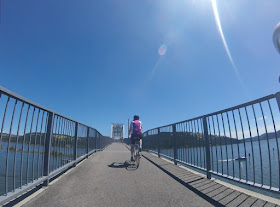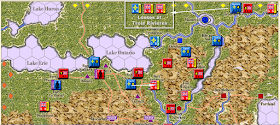 |
| British clearing the woods |
In the first fight at Foz d'Arouce, Ney and his French command were handed a serious defeat. Those Frenchmen not drowned in the swollen river either perished at the hands of the British, laid down their arms in surrender, or routed away to the north bank of the Ceira. It was a bloody rebuke to Ney's insubordinate actions. For a reminder of the first combat at FdA, please see, BatRep: Combat at Foz d'Arouce.
With a refight on the agenda for Friday Night at the Fights, what could be expected in a rematch? In this action, Jake once again took command as Wellington while I accepted the heavy task of reversing Ney's misfortune. Anyway, on to the game.
 |
| Ney is surprised by Wellington's aggression so late in the day. Mermet in foreground. Marchand in background defending Poisao. |
 |
| Elements of Picton's Division pass through a small village on march to Foz d'Arouce. |
 |
| While initiative swung back and forth early on, musketry exchanges on the French right favor British fire discipline. |
 |
| Marchand's legere tangle with Portuguese Cacadores in a close range firefight. |
 |
| French legere blunt the attack of Craufurd's Light Division on the French right. With legere protecting Poisao, the British cannot mount an effective attack against the crucial village. Yet. |
 |
| French prepare to defend the wooded heights while reinforcing the valley between Mermet's hill and Poisao. Casualties are rising on both sides of the battle lines with the French suffering more. |
 |
| Casualties increase in a close range firefight. |
 |
| The bold charge of the French lights allows the remainder of Mermet's command to temporarily consolidate on a new line of defense. |
 |
| The defense of Poisao. |
 |
| In a measured retrograde, Ney's force slowly gives ground as it converges on the bridge. |
Even with a more forward French defense than seen in Game 1, the French in this game sustained fewer casualties and held the objectives much longer. More than half of Ney's command was in the Dead Pile at the end of Game 1. Although this game unfolded in a very similar manner, only two French battalions had scattered by game's end. This version of the battle lasted for ten turns before play was stopped due to time. The first playing was stopped before seven turns could be completed with French capitulation. Interestingly, the two reinforcing battalions the French received in this game had no impact on play. Neither got caught up in the action and were underutilized.
The Anglo-Portuguese force was a formidable juggernaut. It advanced steadily and dished out much punishment. British fire discipline gave the Allies a decided advantage. Since such superb fire tendency is additive to Combat Effectiveness, perhaps, the British ought to be re-rated to meld the two? Initiative played a role in this game. While initiative swung back and forth for the first few turns, after about Turn 5, Wellington seized the initiative and held it throughout the remainder of the game. Wellington's command structure and capability lent itself to the dominating attack presented. On the British right, the two commands worked in tandem to one-two punch Mermet's command.
For the French, this is a tough scenario win. Perhaps an early, aggressive French player can mitigate some of the British advantages? The two instances when French legere charged into close combat, both were successful in halting a British advance. While only one such charge was tactically a success, both did the job of breaking up and disordering the British attack.
As in Game 1, Game 2 saw the British position their two horse guns on the heights overlooking Poisao; a perfect placement for artillery. What if the French had utilized Lamotte's cavalry to take the ground before the British could arrive? The French provisional light cavalry likely would be expended in this endeavor. That plan might be worth pursuing. As it was, Lamotte's cavalry took no active roll in the battle beyond being a target for British guns.
Congratulations to Jake for a well-played and deserved victory for the Anglo-Portuguese. As always, it was good fun.
After two playings of the scenario, it might be easy to imagine Massena's displeasure upon hearing that Ney had taken up positions on the south bank of the Ceira River to offer a fight. After witnessing two successive French losses, I feel his pain.



















































